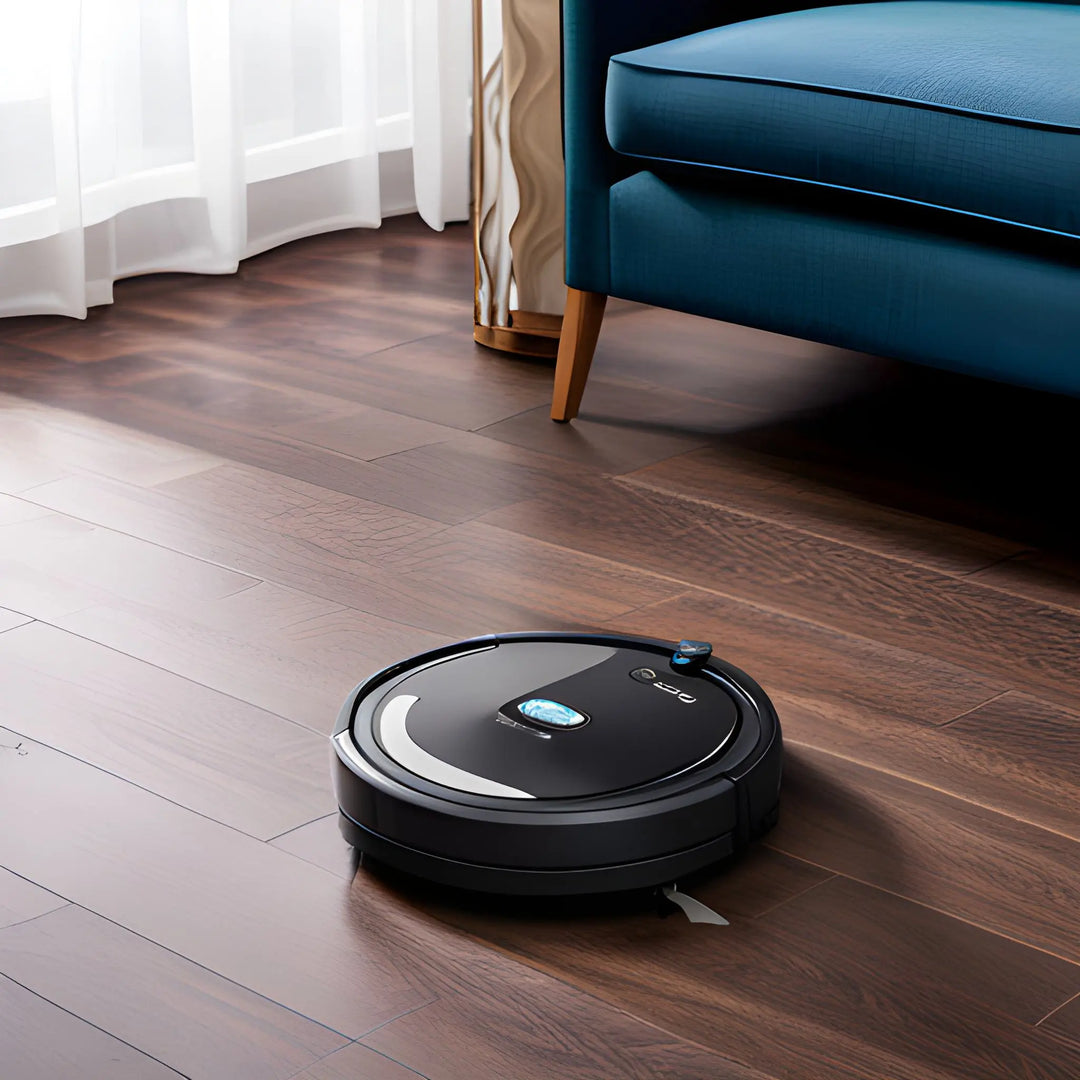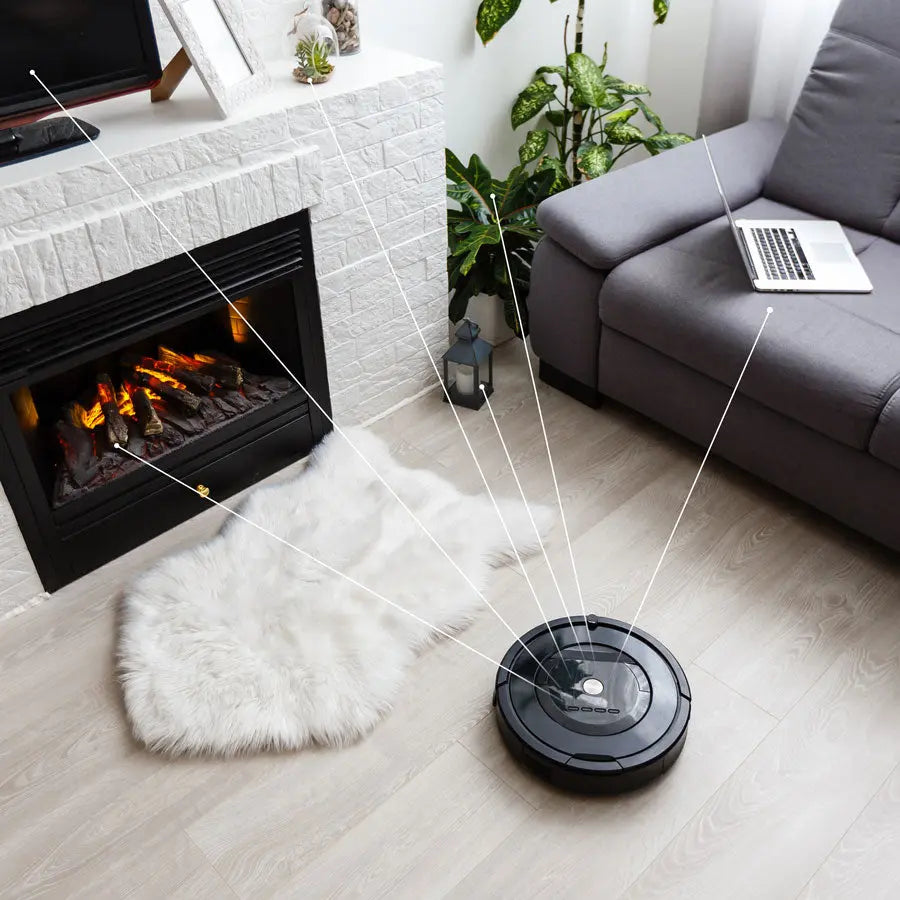A Complete Overview of Robot Vacuum Navigation
What is SLAM navigation anyways? And where can I get a LIDAR? Isn't a gyroscope something for ships?
If you find yourself scratching your head and asking some of these same questions, you have come to the right page! Over here at robotvacuums.com we have done the research for you, and we are glad to present you with our comprehensive overview below.
Complete Overview of Robot Vacuum Navigation
Robot vacuums have made significant advances since the early days of bounce and bang navigation. While older robots simply plowed through your home, running into things until they had cleaned all of the floor they could reach, today’s high-tech robots can form a highly detailed map of your home and intelligently plot out the most efficient path to clean as thoroughly as possible.
They do this using a wide range of sensors and impressive artificial intelligence. Of course, the old bounce and bang model is still an option, and it may even be the right one for you depending on your budget and needs. Here's what you need to know about how robot vacuums make their way around your home and how to choose the right kind of navigation for your needs.
Sensor Mapping
Sensor-based navigation is the most primitive type of navigation, and what you are likely to see in the earliest versions of robot vacuums. Today, the most inexpensive robot vacuums are often equipped only with sensor mapping.
However, almost all robot vacuums rely on a range of sensors to help them make their way around your home and to troubleshoot potential safety issues for the robot such as falling down stairs. More basic robots are entirely dependent on these kinds of sensors to get around. More advanced robots use sensors to enhance their cleaning capabilities. Some robots, like the ILife A80, use sensors for navigation but also feature more advanced cleaning sensors like carpet detection, all for an extremely reasonable price under $150.
Here are some of the sensors that may be utilized:
- Drop detectors. Practically all robot vacuums are equipped with drop detectors. These sensors prevent them from falling down stairs or other large differences between levels. Drop detectors can be very convenient not only because they protect your robot from falling down the stairs but also because they can keep your robot from going over a steep threshold or across another barrier. They make it much less likely that your robot will take on a deeper drop than it can handle and end up upside down or damaged.
- Wall sensors. Wall sensors keep the robot vacuum from pinging off of walls and large furniture, making a lot of noise and potentially doing damage as they go. They also help robots to navigate along the walls. Wall sensors are very helpful in Edge Mode, in which robots follow walls where debris tends to accumulate. These sensors also help robots to navigate from one room to another and to know where walls are so that they can zig-zag from one wall to another.
- Obstacle sensors. Robot vacuums that are equipped with excellent obstacle sensors can avoid even obstacles as small as shoes or toys. The best can keep themselves from getting tangled up in wires, although most robots struggle to avoid wires. Often, robots are programmed to keep approaching obstacles from different angles to make it more likely that they will successfully pick up all of the dirt around the obstacle. They may also push against an obstacle to see if it is soft, such as a curtain, so they can push through and continue cleaning.
- Carpet sensors. Robot vacuums are sometimes equipped with carpet sensors that can help them to identify where there might be carpet in your house. They can use this information to help them avoid mopping over the carpet or to boost vacuum power on the carpet where greater suction may be required to get all of the debris.
- Dirt sensors. Dirt sensors can be a very useful feature in robot vacuums. When a robot senses a dirtier space it can clean the area more thoroughly. Since it may otherwise take several passes for a robot to pick up a concentrated mess, a dirt sensor that can tell the robot to make multiple passes over an area of extra dirt can be tremendously helpful.
- Optical sensors. Optical sensors are on the wheel of the vacuum. They tell the robot how much distance it has traveled. They may also use light sensors to determine how many times the wheels have rotated. In this way, the robot knows how far it has gone, which can help it to navigate the space more thoroughly, plan a route, and know when it needs to return to the base to charge.
- Battery sensor. At first glance, it may not seem that the battery sensor is relevant to navigation. However, many robots return to the base when they need to charge. In order to do this, they need to be able to sense when their battery is getting low. Furthermore, they need to know how far they've gone from the base. Otherwise, they won't be able to make it back on the charge that they still have.
Camera Mapping
Some robots use a built-in digital camera to navigate your home. Some of these robots, like the Trifo Lucy AI, may even double as security cameras by letting you see what they see. Cameras are sometimes used with SLAM navigation, which is highly effective. Without SLAM, robots that use camera mapping are often fairly affordable and can still be pretty efficient. Camera navigation alone is a reasonably effective way to navigate, but it does have some important downsides.
Just as you can't see well or get around your house easily in the dark, neither can a robot vacuum that depends on camera mapping. These robots may not function well at night. Some are equipped with their own source of light. Camera vacuums with a light eliminate the issues of navigating at night. However, they have their own problems of having a light beam around your house in the dark.
Another issue with camera mapping is that robots can mistake dark tiles or carpets for a drop. They may not go under the shadows of furniture for the same reason. While these cameras tend to be quite good at interpreting what they see, they are far from perfect when it comes to dark spots.
For the same reason that camera mapping robots aren't great at navigating in the dark, they may also have trouble navigating in deep shadows. This can make these robots more prone to being stuck underneath furniture or refusing to go under furniture in the first place.
Gyroscope Navigation in Robot Vacuums
Gyroscopes can calculate the distance from the robot to obstacles in your house. They use either a quickly spinning wheel or a beam of light that circulates to determine where objects in your home are relative to the robot vacuum.
Gyroscopes have been used for many years as a navigation tool in aircraft, ships, and cell phones. They are also highly effective when it comes to your robot vacuum. A great robot with gyroscope navigation, like the Tesvor x500, can get the job done well for under $200. They typically work as rotation sensors as well, enabling them to better understand where the robot is in relation to obstacles in your home.
Gyroscopes can keep robots from bumping into things and even form a basic map of your home. Gyroscope navigation may not be quite as effective as systems that use lasers, such as Lidar and SLAM, but they can do the job pretty well at a significantly lower cost.
SLAM
SLAM stands for “Simultaneous Localization and Mapping”. It is a technique utilized by robot vacuums to create a map of the environment. It also tracks where the robot is within the environment.
Often, this visualization is displayed using an app. Using this tool, you can see where your robot is at any given time. Furthermore, you'll be able to see where the robot has cleaned and how it has organized your home. In the most advanced robots, like the Tesvor S6, you can also clean by area and set no-go zones using the map.
You can usually tell that a vacuum is using SLAM at first glance. Without SLAM, vacuums appeared to have much more random navigation, ping-ponging around the room from obstacle to obstacle or having difficulty clinging to edges or moving smoothly around furniture. However, with SLAM, the vacuum tends to move in straight, logical lines and around edges and corners effortlessly.
A SLAM system can utilize Lidar or use a camera. When SLAM uses a camera, it is typically referred to as “visual-inertial odometry”. The robot uses a motion sensor to determine how the robot is moving through your home as time goes on.
An algorithm sets specific data points in your home which it then uses to help it calculate where the robot is and where important points of your home are. These points are often set where there are doorways.
The algorithm will automatically separate rooms using its understanding of where the doorways are. It will then divide your home into areas based on these rooms. Often, artificial intelligence even makes a guess as to what the rooms are. You may also be able to name the rooms yourself.
Sometimes, you can change the areas created by the robot. Once created, these areas allow for features like cleaning by area or staying out of a given area.
SLAM navigation is very good, but it isn't perfect. Projection error is fairly common. When this error occurs, the robot has a hard time understanding exactly how far it is from a given point. This can lead to errors in navigation and problems with robots running into obstacles.
Lidar
The newest and most advanced robots on the market, such as these excellent options by Dreame, typically utilize Lidar, which stands for “Light Detection and Ranging”. Lidar is a type of SLAM navigation. It uses multiple lasers to illuminate objects in the room and then measures the reflected pulses of light to determine where the robot is relative to obstacles in the space.
Lidar enables the robot to map out a space, including distances between objects in the room. Using this map, it can create the most effective possible path, ensuring that it gets to every inch of your home and doesn’t repeat its efforts.
One potential issue with Lidar is that if an object is in the way or if it has an inconsistent shape, it may not be understood properly by the robot. This can lead to issues when it is mapping a space that somebody is moving through or when an inconsistent object like a drape is in the way. Furthermore, Lidar can't see extremely small objects.
Lidar is typically excellent at detecting relatively small obstacles like a pair of socks on the floor or the dreaded pile of dog poop. However, it has trouble seeing very small obstacles like cables and wires.
This is a problematic shortcoming, since cables and wires are an important problem for robot vacuums. Robot vacuums can be damaged when they suck up wires or get them tangled around their wheels. Furthermore, they have a tendency to pull down whatever the wire is plugged into.
One great solution is using no-go zones to prevent robot vacuums from going places where there are lots of wires. No-go zones won’t be much help if you've forgotten that you left your laptop plugged in on the coffee table with the wire strewn across the floor, but it can at least keep the robot from going behind your computer desk or other places where wires are very likely to be found.
How to Choose the Right Navigation for Your Robot Vacuum
Now that you understand the various types of navigation that are available for robot vacuums, you're doubtless wondering how to choose the right one for your needs. Here are a few considerations to help you make an educated decision:
Cost
The first question that you need to ask yourself is how much you’re willing to spend on a robot vacuum. If cost isn’t a factor, you’ll probably choose a vacuum that utilizes SLAM and Lidar to create the most accurate possible map of your home and clean your house as well as possible. This is the best kind of navigation on the market, and there are really no advantages other than cost to choosing a different kind of navigation.
However, if you have some budget constraints (as most people do), you'll need to factor cost into your decision. You’ll pay more for the best navigation. If you’re working within a budget, this may mean that you have to make compromises in other areas.
Would you rather have a vacuum with superb navigation but less suction or would you rather have a super sucker or dual-purpose vacuuming and mopping robot that doesn’t have as good of navigation? The next few considerations will help you decide how best to budget for your robot vacuum when it comes to navigation.
The Complexity of Your Home
The more complex your space, the more important it is for you to choose a robot with excellent navigation. It’s frustrating to find that your robot vacuum always misses a space in the corner of a room or that it has a difficult time effectively navigating between obstacles.
However, if you have a straightforward layout with a few simple pieces of furniture that can easily be lifted or set aside, paying for a complex navigation system may not be worth it.
How Much do Bumps Matter?
The most inexpensive robot vacuums are most likely to run into your things. Simple robots navigate with a “go until you find an obstacle” sort of mentality. While many of these robots do have bump sensors to keep them from running into things, they aren't nearly as good at avoiding obstacles as robots with advanced laser navigation.
If you aren't worried about the sound of a robot bouncing around your home or a few scratches on your furniture, you can save a lot of money by going with a robot that just has obstacle avoidance rather than laser navigation. However, if having paint scuffed or chair legs scratched is a deal-breaker for you, better navigation is important.
How Quickly Does it Need to Get the Job Done?
Given enough passes and sufficient time, practically any robot vacuum with decent suction will eventually get your home clean. Even if the navigation isn't very good and the robot makes multiple passes over one area and only a couple of passes over another, with the opportunity to make enough passes, it will eventually go everywhere and clean everything.
However, it can be pretty time-consuming for less efficient robots to make their way around your home. If you don’t have a home that gets particularly dirty and you don't mind running the vacuum several times every night while you're sleeping or every day while you're at work, you may find that even a robot without very good navigation manages to do a decent job of keeping your home clean. If, on the other hand, you want to be able to run your vacuum once every few days and be confident that it got everything, paying for highly efficient navigation may be worth your while.
Pick the Right Navigation for Your Robot Vacuum
The best robot vacuum for you may be on the pricier side with Lidar and SLAM but be incredibly efficient and able to clean your home thoroughly in only a few hours. Your ideal robot may take quite a few passes to get the job done using only obstacle avoidance sensors but will save you a lot of money. Perhaps the robot you choose will land somewhere in the middle with camera or gyroscope navigation that does a decent job of navigating but won’t be as quick or efficient (or as expensive) as Lidar or SLAM.
Unless you have limitless funds with which to purchase a robot vacuum, it is well worth taking some serious consideration into whether you really need the best navigation for your robot vacuum. Of course, if you do need great navigation, you won't be satisfied with anything less. Depending on the money you have to spend, the complexity of your home, and how quickly you need your robot vacuum to get the job done, different types of navigation may work best for you.





